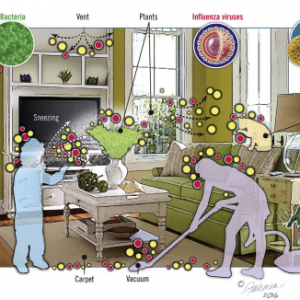“If there is magic on this planet, it is contained in water” -Loren Eiseley- Aquatic ecosystems can be placed into two discrete categories, native and managed. Native aquatic ecosystems may be influenced by human activities, in fact we’d be hard-pressed to find one that isn’t, but there is no intention to the influence. Managed aquatic …
A recent study form Ling et al explored microbial community succession on concrete. They examined the concrete in two sewage manholes over a year using 16S rRNA sequencing. Concrete is a huge part of urban environments, and corrosive microbes eat it away. This causes structural damage, which is especially unwanted in sewage systems. The abstract for the …
By Amanda Makowiecki Miller Research Group University of Colorado, Boulder With drug resistant bacteria becoming a growing problem, alternative methods are being pursued to decontaminate air and surfaces; ultraviolet germicidal irradiation (UVGI) is one of these methods. UVGI uses short wavelength light in order to disrupt the genetic material of microorganisms, this disruption either kills …
Back in October 2013 I wrote a blog post here called “Building science measurements in the Hospital Microbiome Project: Part 1” where I described the types of building environmental and operational measurements we were making at the time as part of Jack Gilbert’s Sloan-funded Hospital Microbiome Project (Jeff Siegel at the University of Toronto also played a …
I wrote a post on the Seagrass Microbiome website yesterday about my struggles with fungal ITS sequencing data which I thought I’d share here as well in case anyone is looking to jump into the fungal fray. To summarize: changing the default method of the QIIME assign_taxonomy.py script from “UCLUST” to “blast” dramatically increased the …
When drainage systems fail, a lot of undesirable effects may follow, from leaks that cause mold to fecal-laden water contaminating groundwater and houses. A study from the Heriot Watt University in Edinburgh, Scotland found yet another concern we should have about broken or inadequate building drainage. Airflows in pipes can contain aerosolized pathogens and then escape into …
By Amanda Makowiecki 1st Year Mechanical Engineering PhD Student Miller Research Group, University of Colorado Boulder Researchers at the University of Oregon recently published a paper examining the connection between architectural design and microbial diversity in our buildings (Kembel et al. 2014). Although occupancy type was identified as the strongest predictor of microbial variation, several …
IBM and Mars put out a joint press release today announcing a new effort to use metagenomics to study microorganisms in the food supply chain. The new initiative, called the Sequencing the Food Supply Chain Consortium (SFSC), will use metagenomics and metatranscriptomics to establish what they call a “microbial baseline” that can later be used …
Today, humans spend ~90% of their lives roaming the ‘great indoors’, which is very different from the outdoor environments where we co-evolved with our commensal microbiota (Kelley and Gilbert, 2013). We are just beginning to understand how the design of built environments (BEs) influences our microbiome, and how these interactions, in turn, might affect human …
Guest Blog Post by Dr. Nick Clements, PhD Post-doctoral Researcher, University of Colorado Boulder, Miller Research Group In the event of a disaster, hospitals must have plans in place for receiving a surge of patients with a variety of possible infectious diseases or conditions. Pandemic-causing infectious diseases, such as the viruses that caused the SARS …
